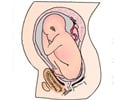Preeclampsia, a sudden pregnancy complication that can interfere with the blood flow to the placenta can now be detected with a blood test in the first trimester.

‘Circulating small RNA molecules in the first trimester can be used as a diagnostic tool to detect preeclampsia.’





It is also a leading cause of maternal mortality in the US. A new Tel Aviv University study identifies novel molecular biomarkers of preeclampsia, signaling the potential for an early diagnostic blood test. Research for the study was led by Dr. Noam Shomron and Prof. Moshe Hod and conducted by Liron Yoffe and other lab members, all affiliated with TAU's Sackler School of Medicine, and in collaboration with Prof. Kypros Nicolaides of King's College, London.
"Up to eight percent of pregnant women may contract preeclampsia during their second or third trimester," Dr. Shomron says.
"This is a serious disease that endangers the health, sometimes even the lives, of the mother and the fetus. We don't know what causes it, but preeclampsia, if caught in time, has a simple and proven remedy: low doses of aspirin administered from the 16th week until the end of pregnancy."
Turning to genetics
Advertisement
"Our findings form the basis for a simple blood test that would predict preeclampsia and, in turn, allow doctors to provide treatment that would prevent the very onset of the disease."
Advertisement
The researchers extracted the RNA molecules (snippets of molecular information present in human cells) from the plasma of the samples and sequenced these using Next Generation Sequencing (NGS). The scientists discovered the new biomarkers by analyzing the data using computational methods that included statistical analyses and machine learning algorithms.
"We identified 25 small RNA molecules that were differentially expressed between the preeclampsia and the control groups. Based on those RNA molecules, we then developed a model for the classification of preeclampsia samples," says Liron Yoffe.
"These findings indicate the predictive value of circulating small RNA molecules in the first trimester, and lay the foundation for producing a novel early non-invasive diagnostic tool for preeclampsia, which could reduce the life-threatening risk for both the mother and fetus."
Early diagnosis leads to early prevention
According to Prof. Moshe Hod, the new research follows a global trend, which "seeks to establish pregnancy tests in the first trimester, as opposed to today, when most tests are performed in the third trimester."
Prof. Hod, the President of the European Association of Perinatal Medicine and Chairman of The International Federation of Obstetrics and Gynecology (FIGO) Committee that deals with maternal and offspring health, is leading a global effort to develop new diagnostic techniques to improve prediction and prevention of complications like gestational diabetes, preeclampsia and preterm birth in the first trimester of pregnancy.
"Early testing or prediction will allow doctors to safeguard the health of mother and fetus alike. It will also facilitate, if necessary, early preventive interventions to improve maternal and offspring's outcome," concludes Prof. Hod.
"The samples recently collected from other countries -- Italy, Spain, Russia, and in particular Israel -- will be used to apply our findings collectively to patients from around the world," adds Dr. Shomron.
Source-Eurekalert















